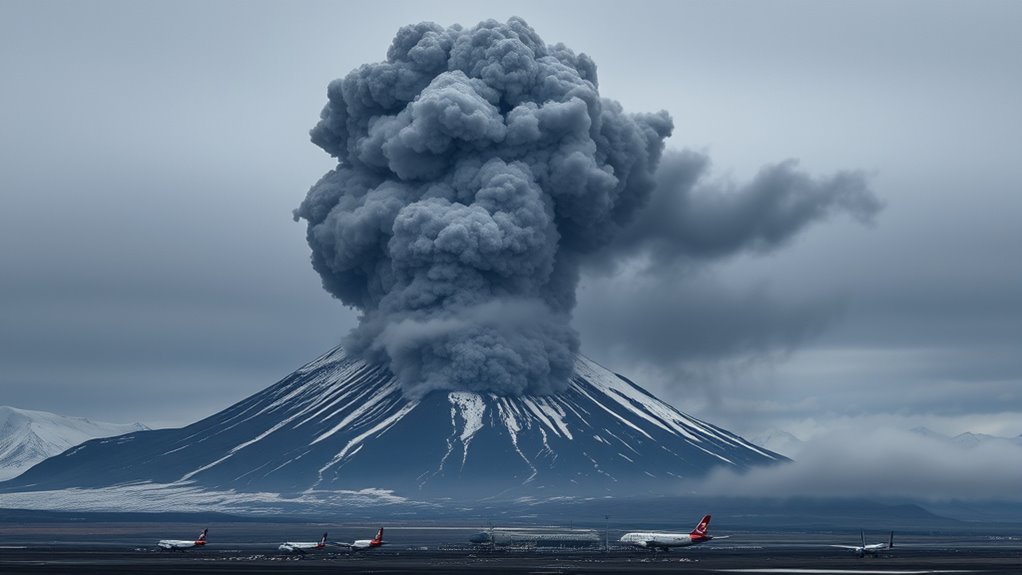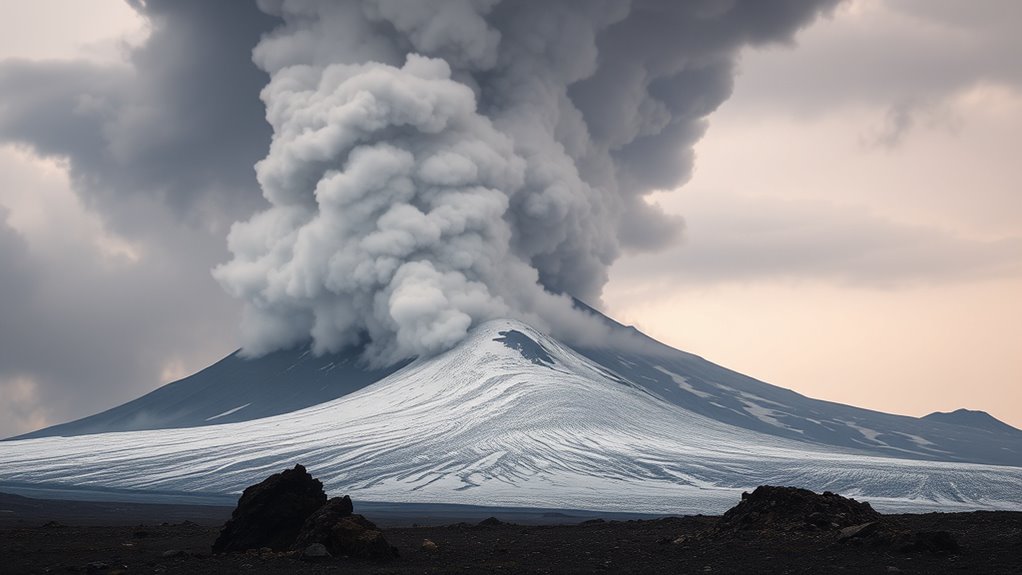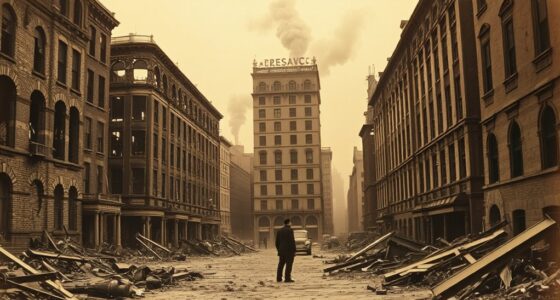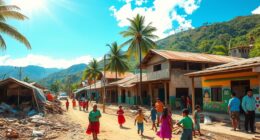The 2010 eruption of Eyjafjallajökull produced a massive ash cloud that disrupted air travel across Europe and beyond. This caused airlines to cancel thousands of flights, resulting in billions of dollars in losses. The ash also affected supply chains, tourism, and global markets, highlighting how interconnected and fragile modern transportation and economies are. If you want to understand how this volcano impacted the world and what lessons it taught us, keep exploring the details.
Key Takeaways
- The 2010 eruption of Eyjafjallajökull released a massive ash cloud that disrupted air travel across Europe and globally.
- Aviation shutdowns caused airlines to lose millions daily and led to billions in industry-wide costs.
- The eruption affected supply chains, delayed shipments, and impacted businesses relying on international logistics.
- It exposed vulnerabilities in transportation networks, prompting improvements in monitoring and contingency planning.
- The event highlighted how natural phenomena can have wide-reaching economic and societal consequences worldwide.

Have you ever wondered how a single volcanic eruption can ripple across the entire globe? When Eyjafjallajökull erupted in 2010, it unleashed a massive ash cloud that spread across Europe and beyond, creating chaos in ways you might not expect. One of the most immediate effects was widespread air travel disruptions. Airlines canceled thousands of flights because ash clouds pose serious risks to jet engines, forcing airports to shut down or limit operations. This sudden halt in air travel didn’t just inconvenience travelers; it created a domino effect that affected industries, economies, and everyday lives worldwide. You might have noticed the scarcity of flights, the stranded passengers, or the sudden surge in travel costs, all stemming from this volcanic event.
The disruption of air travel had profound economic impacts. Airlines lost millions of dollars daily, with cancellations and rerouted flights costing the industry billions overall. Airports faced closures, causing logistical nightmares and revenue losses. Businesses that rely on international travel and shipping suffered delays, impacting supply chains and productivity. Travel agencies, hotels, and tour operators saw sharp declines in bookings, and the ripple effect extended to local economies dependent on tourism. Even countries not directly in the flight paths felt the pinch as delayed shipments and canceled conferences disrupted commerce. The economic impact wasn’t just short-term; it revealed how interconnected the world’s economy truly is, where a volcanic eruption in Iceland could destabilize markets and disrupt global trade.
Beyond just the immediate economic consequences, these disruptions highlighted vulnerabilities in global transportation networks. Governments and industries realized that volcanic ash clouds, which might seem like a natural phenomenon, could cripple economic activity if not managed effectively. This event prompted airlines and authorities to develop better monitoring systems and contingency plans, but it also underscored the fragility of modern interconnected systems. You might now be more aware of how a single natural event can have cascading effects, reminding us that natural forces often operate beyond human control yet influence every aspect of our daily lives. Additionally, the event emphasized the importance of color accuracy and technological resilience in modern systems, which can mitigate some of these impacts.
In the end, Eyjafjallajökull’s eruption showed that a volcanic event isn’t just a spectacle of nature; it’s a catalyst for global disruption. You experienced firsthand how air travel disruptions triggered economic ripples that traveled far beyond Iceland’s glaciers. It made clear that natural phenomena can threaten our interconnected world, forcing industries and governments to adapt and prepare for future surprises. The ash cloud’s impact was a wake-up call—one that emphasized the importance of resilience and readiness in our globalized society.
Frequently Asked Questions
How Did the Eruption Impact Iceland’s Local Communities?
You saw how the eruption challenged your community, disrupting daily life and local businesses. Despite this, your community demonstrated resilience by supporting each other and adapting quickly. The event slowed economic activity initially, but your community worked together to recover, focusing on rebuilding and strengthening local industries. Your shared efforts helped guarantee a faster economic recovery, showing the strength and unity needed to overcome natural disasters.
What Technologies Were Used to Monitor the Ash Cloud?
Think of the monitoring tools as your vigilant eyes in the sky. You used satellite imaging to track the ash cloud’s movement and ash dispersion modeling to predict its spread accurately. These technologies helped you stay ahead of potential disruptions. By combining real-time satellite data with predictive modeling, you could assess the ash cloud’s behavior, ensuring safety and minimizing air travel chaos during the eruption.
How Did the Event Influence Future Volcanic Eruption Preparedness?
The event prompted you to enhance volcanic risk assessment and emergency planning. You now prioritize real-time monitoring and better communication strategies to minimize disruptions. This experience led to improved international collaboration, ensuring quicker responses to eruptions. You understand the importance of integrating scientific data into preparedness plans, making communities more resilient. As a result, future volcanic eruptions are met with more effective measures, reducing their impact on society and the economy.
Were There Any Long-Term Environmental Effects From the Ash?
Long-term environmental effects from ash deposition are subtle but profound, like a slow-changing canvas. You might notice soil fertility improving temporarily or altered waterways, yet the ash’s impact generally fades over time. It can disrupt ecosystems initially, but nature often adapts, restoring balance. While some areas experience lasting changes, most environments gradually recover, turning the ash’s transient presence into a chapter of Earth’s ongoing story.
How Did the Aviation Industry Adapt After the Eruption?
After the eruption, you’ll see that the aviation industry adapts by implementing stricter airline safety protocols and air traffic rerouting strategies. These measures help prevent ash-related hazards, ensuring passenger safety and minimizing disruptions. Airlines now monitor volcanic activity more closely, communicate promptly with air traffic control, and reroute flights proactively. This proactive approach keeps air travel safer and more efficient, even during volcanic events, ultimately reducing delays and cancellations.
Conclusion
You’ve seen how Eyjafjallajökull’s eruption grounded over 100,000 flights across Europe in just weeks, affecting millions worldwide. This event shows how a single volcano can disrupt global travel and economies in a blink. The ash cloud stretched over 12,000 kilometers, reminding us how interconnected our world truly is. Next time you hear about a volcanic eruption, remember, even a small mountain can cause huge ripple effects everywhere.










